Concrete Cube Fails in Test After 28 days:
In this Article today we will talk about the Concrete Cube Fails in Test After 28 Days | Concrete Cube Failure Reasons | Failure of Concrete Cube in Compression | Acceptance Criteria Concrete Cube Test Results | Concrete Cube Compressive Strength | Strength of Concrete at Various Ages
What Next If Concrete Cube Fails in Test After 28 days:
What Next if concrete cube fails in test after 28 days, Such a situation arises many times on the construction site. This article explains to you what to do and not do during such type of situation on the construction site.
So, what to do if the cube test fails? There are many repair and rehabilitation option if the concrete cube fails in the test. Concrete Cube Failure Reasons
Concrete Cube Compressive Strength
The Concrete cube test provides details about all the characteristics strengths of concrete. From the result of this cube test, we can judge whether Concreting has been done properly or not.
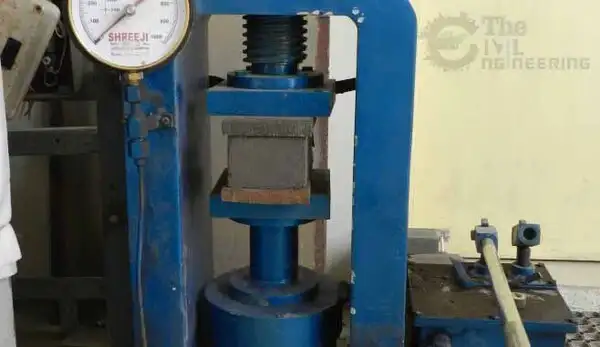
Compressive Strength Definition
“Compressive strength is the ability of material (concrete) or structure to carry the loads on its surface without any crack or deflection. “
The compressive strength is simply the applied load at failure divided by the cross-sectional area of the gauge-section (i.e. σ=P/A).
Compressive Strength Test of Concrete Cubes:
For Checking the compressive strength of concrete two types of specimen samples are used. Cube sample size 15cm X 15cm X 15cm or 10cm X 10cm x 10cm depending upon the size of aggregate are used. Generally, we used molds of size 15cm x 15cm x 15cm. Concrete Cube Failure Reasons
Strength of Concrete at Various Ages
It is a known fact that concrete strength increases with age. Below shows the strength of concrete at different ages in comparison with the strength at 28 days after casting.
- concrete cube test results- 28 days
- 7-day concrete cube test results
- 3 days concrete cube strength
| Age of concrete | Compressive strength Gain (%) |
| 3 days | 30 % |
| 7 days | 67.5 % (70% for safety) |
| 14 days | 90 % |
| 28 days | 99 % (70% for safety) |
Concrete Strength of Cube at 7 and 28 Days Test
Acceptance Criteria Concrete Cube Test Results:
| Grade of Concrete | Minimum compressive strength N/mm2 at 3 days (30%) | Minimum compressive strength (N/mm2) at 7 days (70%) | Specified characteristic compressive strength (N/mm2) at 28 days(100%) |
| M – 15 | 4.5 | 10 | 15 |
| M – 20 | 3 | 13.5 | 20 |
| M – 25 | 7.5 | 17.5 | 25 |
| M – 30 | 9 | 21 | 30 |
| M – 35 | 10.5 | 21 | 35 |
What To Do If Cube Test Fails In Test After 28 days:
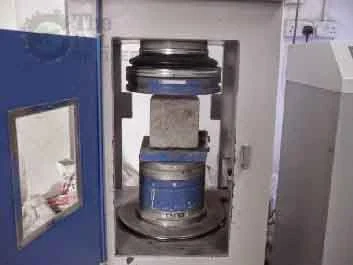

- The first reaction is ” Prevention is better than cure”- The failure of the Cube test depends upon the various aspect even the way it has been tested is also important. The sampling for the cube is also very important.
- The failure result of a concrete cube is a serious issue. You need to analyze why the cubes have failed.
- By finding out a proper reason for failure, we may avoid further reoccurrences of the same. concrete cube fails in test after 28 days
- When we are doing concreting on site and collecting Samples for the test there are four possible combinations behind Concrete cube fails in test as listed below.
1. It may be, Concrete is strong; cube is also strong.
2. It may be, Concrete is weak; cube is also weak.
3. It may be, Concrete is strong; but cube is weak.
4. It may be, Concrete is weak; but cube is strong.
- Generally, we focus on the first two possibilities while analyzing cube test results, the third and fourth possibilities are generally being neglected.
- The 3rd option does not harm the structure. But option four….well…it is better to be optimistic in such situations.
- While you get reports showing that the 28th-day cube tests are failed, remember that it is something serious. This test result of the 28th day cannot be treated just like in the case of the 7th-day test failure.
- As we know we must attain 99 % strength on the 28th-day cube test result and tests are considered as the deciding criterion for acceptance of the concrete.
- Before considering that our 28th-day cube test is failed or pass and going deep into our scenario of cube failure, let us quickly see how the cube results are generally interpreted as per IS code. Failure of Concrete Cube in Compression
There are two conditions are to be met for accepting a concrete after cube test as per IS 456 2000 Cl 16.1,
For concrete of grade M – 20 and above,
- The average strength of a group of four consecutive test results should not be less than the greater of fck(20)+ 4 N/mm2 or fck+0.825σ where σ is the standard deviation established
- Individual cube strength should not be less than fck – 4 N/mm2
Let us analyze this with an example.
If 28th days concrete cube test results fail check if the result of all 7 days cubes is the same. If even one passes the acceptable criteria you are sure that the concrete mix is OK.
- Now the question of workmanship.
- Even if one of the cubes is OK wait for a 28 Day result.
- If 28 days result fails then again there is a possibility that cubes are not filled properly or they were not cured properly in the first 7 days. But it is possible that slab concrete is OK. Go for the Hammer test.
- If the hammer test is also as per failed cube result then go for core cutter and test it to get actual strength of laid concrete
- Take this core cutter result to consultant and he will make a decision whether he can retain the concrete with rectification like grouting and all. If not, then whether he can find ways to strengthen the slab. If not, then he has to get the slab recast.
We must consider following before any decision is taken by site engineer on discarding concrete
- Whether cubes filled by a trained supervisor?
- Whether the strength is unacceptable as per the acceptable formula?
- if so whether they satisfy the designer with corrective methods as suggested and NDT test results received from labs?
- Still doubtful go for loading test? In many cases, I have experienced horrible results by few labs but the site engineer should have his own judgment about the place of concrete where failed and taking risks.
- The contractor shall always happy if reduced rates are paid for such works but always note any failures needs your pre-action reports as suggested above and that only a site person can decide to discard concrete Failure of Concrete Cube in Compression
Concrete Cube Failure Reason
The following are the major reasons behind concrete cube failure,
1) Wrong Mix Poured: The concrete mix prepared is not as per the approved mix design for that particular strength.
2) Wrong Mix Design: There is a mistake in concrete mix design. It is not properly designed and strength is not properly calculated.
3) Improper Sample Collection: Sometimes concrete sample for cube test is not collected by a skilled worker or it may not checked by a technical person on site. So, there may be possibilities that the collected concrete sample is not truly representing the fresh concrete supplied at site.
4) Improper Cube Preparation: The concrete cure must be prepared as per the guidelines given in IS 516.
Compressive strength of concrete cube might be affected by several errors during cube casting such as,
Improper alignment of cube mould : Which is resulting in distorted cube shape.
Improper / inadequate tamping: Improper tamping result in voids formation in cube sample
Improper filling of the moulds: This may result in weak zone in concrete leaving only mortar without aggregate
5) Inadequate Curing of the Cube Samples: The curing of concrete cube must be as per the guidelines given in IS 516.
Once concrete cube prepared the cubes must be covered with wet gunny bags for a least period of 24hrs from the time when water is first added to the concrete.
Then after removed concrete cube from molds and kept under clean water until the time of test. Make sure temperature of curing between 24˚C to 26 ˚C.
6) Testing Wrong Samples: Properly identify the cube preparation marking on cube. Sometime wrong cube sample test.
7) Errors During Testing: This include improper placing of moulds over the CTM, cleaning the surface, seating the cube properly, rate of load application etc.
8) Errors With the Testing Apparatus: This may include the errors with reading display, loading or hydraulic systems or a manual error in reading and interpreting the displayed value.
9) Unauthorized Water-Cement Ratio Correction of the Mix: Sometime for making concrete easily peaceable labour add extra water without consulting technical person on site.
10) Change in Quality of Materials: Sometimes quality of concrete materials used for preparing the concrete mix on site may be different from those used while preparing the trial mix.
11) Batching Plant Error: There may be possibility of batching plant error wrong materials quantity added in mix, due to any mechanical / software error, which went unnoticed. Failure of Concrete Cube in Compression
What to do if we do not want to dismantle the concrete member
We can strengthen the weak member/members to take the originally designed load. This is more advisable than redesign since this method modification is mostly limited to the members that are weak and hence is easy to keep a track on the process.
However, the suitability of this method depends on other factors also. There are many options to strengthen a weak concrete member if Concrete Cube Fails in Test
1. Providing Steel Casing:
Providing steel casing around the structure, especially columns, to make it a composite member to improve its structural performance.
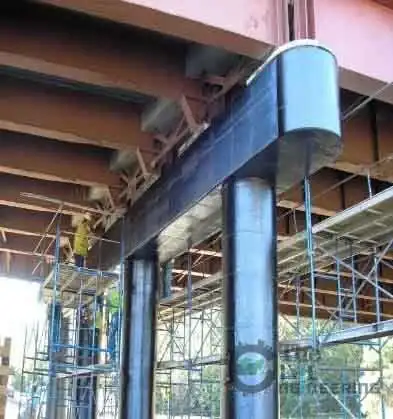
2. Providing Steel Stiffeners:
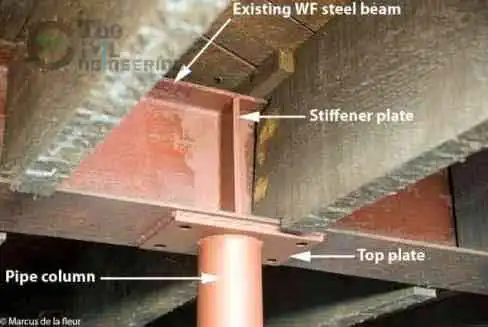
3. Providing Fiber Reinforced Polymer (FRP) sheet bonding:
Reinforced Polymer (FRP) sheet basically with glass fiber – GFRP or carbon fiber and lesser thickness are wrapped around the surface of the concrete member and bonded with epoxy adhesive. So, Concretes structural behavior is improved.
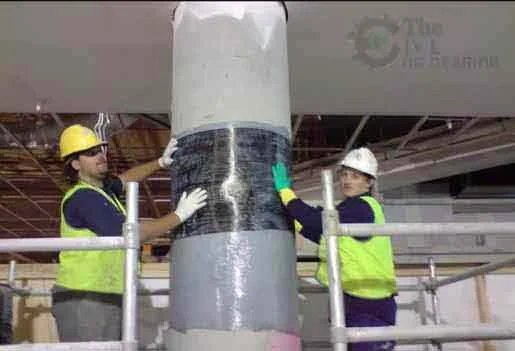
4. Sprayed Concrete / Shotcreting:
Sprayed concrete/shotcrete can be done by drilling reinforcement around the periphery of the member and shotcreting is done on the surface of the member to increase its cross-section to modify the structural performance.

5. Attaching pre-tensioned cables to the concrete members :
Attaching pre-tensioned cables to the concrete member method is not so commonly used. In this method, we induce the effect of the pre-stressed member into the existing member.
6. Concrete Jacketing:
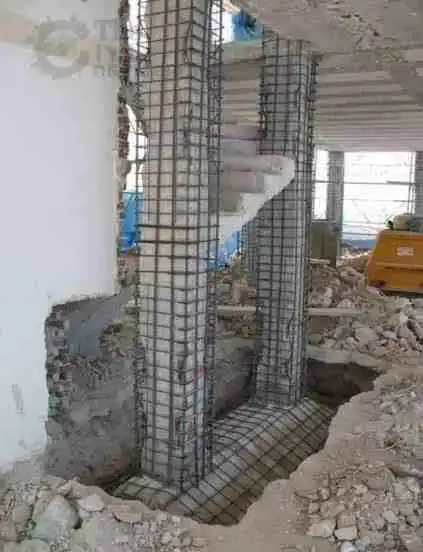
OTHER POSTS:
-
Concrete Slump Test for Workability | Slump Test of Concrete
-
Compressive Strength of Concrete | Cube Test
-
Inspection Checklist for Concrete Placement | Pre & Post Placement
-
Green Concrete Its Advantages, Disadvantages, Application and Materials
-
Concrete Crack Repair | 5 Methods to Repair Concrete Cracks
-
How to Prevent Cracks in Concrete | Types of Concrete Cracks
FAQs:
- The first reaction is ” Prevention is better than cure”- The failure of the Cube test depends upon the various aspect even the way it has been tested is also important. The sampling for the cube is also very important.
- The failure result of a concrete cube is a serious issue. You need to analyze why the cubes have failed.
- By finding out a proper reason for failure, we may avoid further reoccurrences of the same. concrete cube fails in test after 28 days
- When we are doing concreting on site and collecting Samples for the test there are four possible combinations behind Concrete cube fails in the test as listed below.
Conclusion:
Full article on Concrete Cube Fails in Test After 28 Days |Concrete Cube Failure Reasons | Failure of Concrete Cube in Compression | Acceptance Criteria Concrete Cube Test Results | Concrete Cube Compressive Strength |Strength of Concrete at Various Ages. Thank you for the full reading of this article in “The Civil Engineering” platform in English. If you find this post helpful, then help others by sharing it on social media. If any formula of BBS is missing from this article please tell me in comments.


2 Comments
Awesome article. Very informative. Thanks for sharing
Thanks for the comments please visit more articles by clicking on “All Posts” tab of the Menu Bar